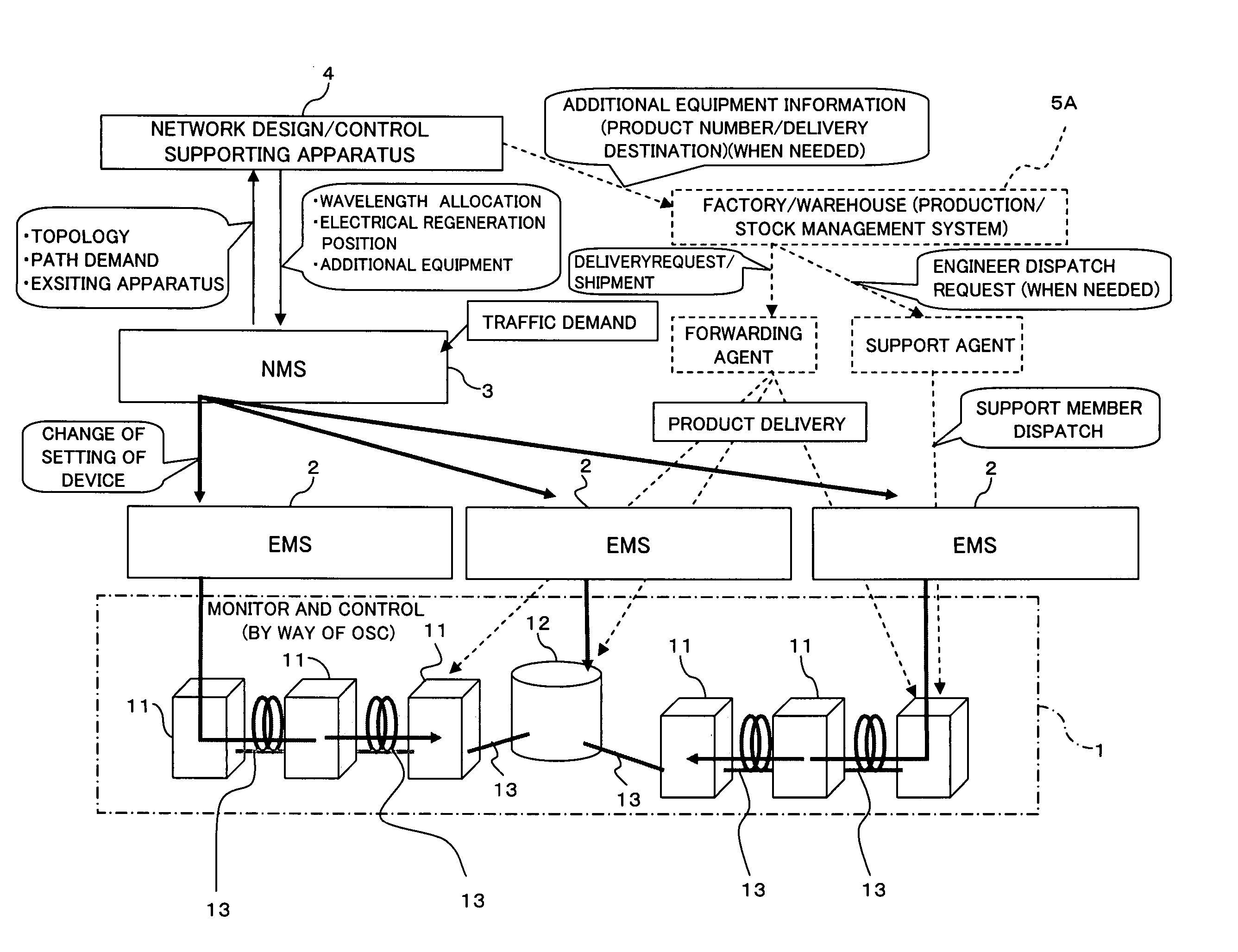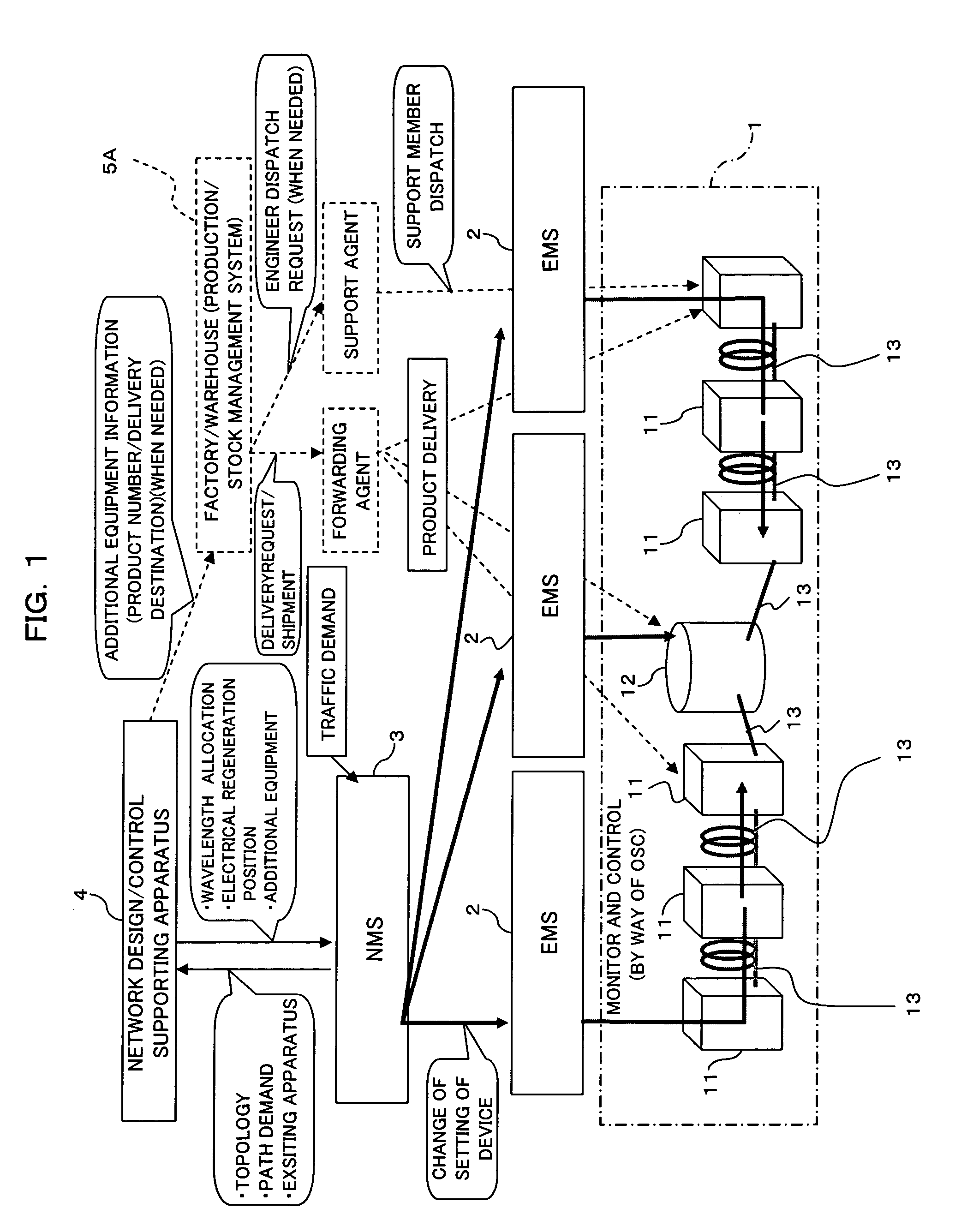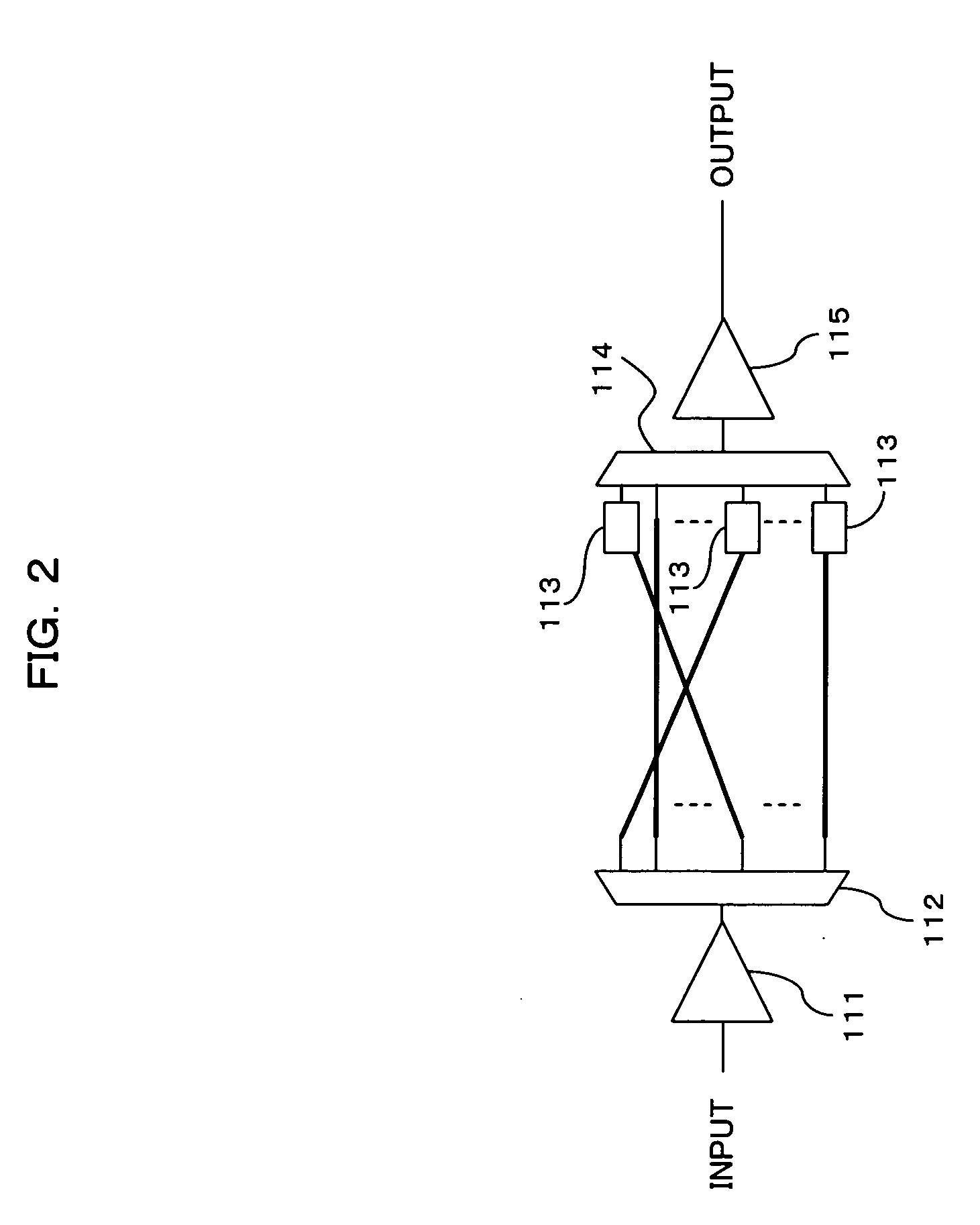[0031] Furthermore, an optical network design supporting apparatus for use in according to the present invention, which is made to selectively dispose one or more optical repeating apparatuses each having a function for selectively carrying out electrical regenerative relay on a plurality of inputted optical signals and a function for selectively carrying out wavelength conversion on the optical signal which is an object of the electrical regenerative relay, the design supporting apparatus comprising storage means for storing wavelength class information on wavelength classes obtained by classification of a plurality of wavelengths available in the optical network according to transmission capability of the wavelengths, recommendation transmission path dividing means for, in a case in which an idle wavelength which satisfies optical transmission over a total optics transmission distance of a recommendation optical transmission path in the optical network for a traffic demand from the external does not exist among the available wavelengths, dividing the recommendation optical transmission path into a plurality of optical transmission sections by the disposition of the optical repeating apparatus, and wavelength allocating means for allocating a wavelength pertaining to, of the wavelength classes obtained by the classification based on the wavelength class information in the storage means, one of a wavelength class equal to a wavelength class, to which a wavelength before the wavelength conversion of the optical signal pertains, and a wavelength class different therefrom which is to be selected on the basis of a difference in total optics transmission distance of the optical transmission section between before and after the electrical regenerative relay.
[0032] In this case, it is also appropriate that the wavelength allocating means is configured so as to, in a case in which the total optics transmission distance of the optical transmission section after the electrical regenerative relay in the optical repeating apparatus is longer than the total optics transmission distance of the optical transmission section before the electrical regenerative relay, allocate a wavelength pertaining to a wavelength class equal to the wavelength class to which the wavelength before the wavelength conversion in the optical repeating apparatus pertains or a wavelength class higher than the wavelength class to which the wavelength before the wavelength conversion pertains, while, in a case in which the total optics transmission distance of the optical transmission section after the electrical regenerative relay in the optical repeating apparatus is shorter than the total optics transmission distance of the optical transmission section before the electrical regenerative relay, allocate a wavelength pertaining to a wavelength class equal to the wavelength class to which the wavelength before the wavelength conversion in the optical repeating apparatus pertains or a wavelength class lower than the wavelength class to which the wavelength before the wavelength conversion pertains.
[0033] In addition, an optical network design supporting method for use in according to the present invention, which is for selectively disposing one or more optical repeating apparatuses each having a function to selectively carry out electrical regenerative relay on a plurality of inputted optical signals and a function to selectively carry out wavelength conversion on the optical signal which is an object of the electrical regenerative relay, the design supporting method comprising the steps of storing, in storage means, wavelength class information on wavelength classes obtained by classification of a plurality of wavelengths available in the optical network according to transmission capability of the wavelengths, in a case in which an idle wavelength which satisfies optical transmission over a total optics transmission distance of a recommendation optical transmission path in the optical network for a traffic demand from the external does not exist among the available wavelengths of the wavelength class information in the storage means, dividing the recommendation optical transmission path into a plurality of optical transmission sections by the disposition of the optical repeating apparatus, and, with respect to the optical signal which is an object of the wavelength conversion in the optical repeating apparatus, allocating a wavelength pertaining to, of the wavelength classes obtained by the classification based on the wavelength class information in the storage means, one of a wavelength class equal to a wavelength class, to which a wavelength before the wavelength conversion of the optical signal pertains, and a wavelength class different therefrom which is to be selected on the basis of a difference in total optics transmission distance of the divided optical transmission section between before and after the electrical regenerative relay.
[0034] In this case, it is also appropriate that a comparison is made in terms of the total optics transmission distances of the divided optical transmission sections and, in a case in which the total optics transmission distance of the optical transmission section after the electrical regenerative relay in the optical repeating apparatus is longer than the total optics transmission distance of the optical transmission section before the electrical regenerative relay, a wavelength pertaining to a wavelength class equal to the wavelength class to which the wavelength before the wavelength conversion in the optical repeating apparatus pertains or a wavelength class higher than the wavelength class to which the wavelength before the wavelength conversion pertains is allocated as a wavelength of the optical signal after the wavelength conversion and, in a case in which the total optics transmission distance of the optical transmission section after the electrical regenerative relay in the optical repeating apparatus is shorter than the total optics transmission distance of the optical transmission section before the electrical regenerative relay, a wavelength pertaining to a wavelength class equal to the wavelength class to which the wavelength before the wavelength conversion in the optical repeating apparatus pertains or a wavelength class lower than the wavelength class to which the wavelength before the wavelength conversion pertains is allocated as the wavelength of the optical signal after the wavelength conversion.
 Login to View More
Login to View More  Login to View More
Login to View More 


